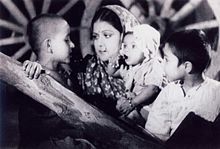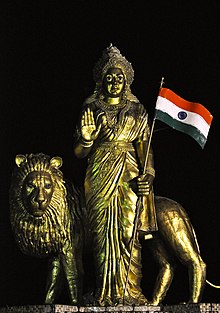Mother India
A remake of Khan's earlier film Aurat (1940), it is the story of a poverty-stricken village woman named Radha (Nargis), who in the absence of her husband, struggles to raise her sons and survive against a cunning money-lender amidst many troubles.
Allusions to Hindu mythology are abundant in the film, and its lead character has been seen as a metonymic representation of an Indian woman who reflects high moral values and the concept of what it means to be a mother to society through self-sacrifice.
It was released in India amid fanfare in October 1957 and had several high-profile screenings, including one at the capital, New Delhi, attended by the country's president and prime minister.
Ashamed of his helplessness (being without arms) and humiliated by Sukhilala for living on the earnings of his wife, Shamu decides that he is of no use to his family and permanently leaves Radha and their three sons, walking to his probable death by starvation.
The title Mother India was inspired by American author Katherine Mayo's 1927 polemical book of the same name, in which she attacked Indian society, religion and culture.
[3] Written against the Indian demands for self-rule and independence from British rule, the book pointed to the treatment of India's women, the untouchables, animals, dirt, and the character of its nationalistic politicians.
[d][7] In 1955, the ministries of External Affairs and Information-and-Broadcasting learned of the title of the forthcoming film and demanded that the director send them the script for review, suspicious that it was based on the book and thus a possible threat to the national interest.
[16] The script was intentionally written in a way that promoted the empowerment of women in Indian society (including the power to resist sexual advances) and the maintenance of a sense of moral dignity and purpose as individuals; this was contrary to what Mayo had claimed in her book.
These themes, present in Aurat, were further developed with a strong sense of nationalism and nation-building, using characters personifying abstract qualities such as "beauty and goodness, wealth and power, poverty and exploitation, and community spirit".
[18] Nargis—the reigning queen of Hindi cinema at the time[19]—had started her career in a leading role with Khan's Taqdeer (1943) and acted under his direction in Humayun (1945) and Andaz (1949).
[27] Before principal photography began, Nargis and Raaj Kumar familiarised themselves with farming practices such as ploughing the fields, reaping and sowing, and cotton picking.
[44] Vijay Mishra, in his 2002 book Bollywood Cinema: Temples of Desire, opined that the Mother India figure is an icon in several respects—being associated with a goddess, her function as a wife, as a lover, and even compromising her femininity at the end of the film by playing Vishnu the Preserver and Shiva the Destroyer, masculine gods.
[47] In contrast, in a 2012 article in the newspaper The Hindu, author Tarini Sridharan has pointed out themes such as upholding female chastity, wifely devotion and saintly motherhood that reinforce gender stereotypes.
[53] The film, an archetypal nationalistic picture, is symbolic in that it demonstrated the euphoria of "Mother India" in a nation that had only been independent for 10 years, and it had a long-lasting cultural impact upon the Indian people.
[60] In his book Terrorism, Media, Liberation, John David Slocum argues that like Satyajit Ray's classic masterpiece Pather Panchali (1955), Khan's Mother India has "vied for alternative definitions of Indianness".
[61] The Radha–Birju relationship is described to have "Oedipal elements" by many authors;[62] Virdi has argued that in her chastity, Radha channels her sexual desires into maternal love for her sons who effectively become "substitute erotic subjects".
[63] Mishra opines that the crushing of the arms of Radha's husband and the mellowness of the older son symbolise castration, which is in contrast with the rebellion of Birju, identified with sexual potency.
[66] Radha's actions at the end of the film in shooting her own son was a breaking of traditional mother-son relationship to safeguard morality, according to author William Van der Heide.
[67] Virdi points out that this brought ambiguity to the mother figure who acts as a sacrificing provider and also as a destroyer, annihilating her own son, something rare in Hindi cinema.
[63] Authors such as Eshun and Woods state that Radha and Ramu are the archetypal champions of virtue in battling hardship and injustice, while Birju is a mischievous child who becomes the anarchist whose uncontrollable rebellion destroys order.
[68] Mishra has noted that although Radha upholds Dharma (the natural law or order) in the film, it is Birju who achieves identification from the spectators; in his rebellion lies the agenda of political action that will usher social change.
[71] Mishra has found metacritical value in Salman Rushdie's commentary on the film in his novel The Moor's Last Sigh (1995) in which Rushdie describes: In Mother India, a piece of Hindu myth-making directed by a Muslim socialist, Mehboob Khan, the Indian peasant women is idealised as a bride, mother, and producers of sons, as long-suffering, stoical, loving, redemptive, and conservatively wedded to the maintenance of the social status quo.
[78] This use of a western-style orchestra in Indian cinema influenced many later films, such as Mughal-e-Azam (1960), which features similar dissonant orchestral music to create the atmosphere at tense moments.
[85] Mother India was dubbed in several European languages including Spanish, French and Russian; it did substantial business in Greece, Spain and Russia and was released in the Eastern Bloc countries.
[86] Mother India was also acclaimed across the Arab world, in the Middle East, parts of Southeast Asia, and North Africa and continued to be shown in countries such as Algeria at least ten years after its release.
[90] A review in a British magazine Monthly Film Bulletin in 1958 remarked that audiences in UK should be grateful that the international version was shortened by 40 minutes, and termed it a "rag-bag pantomime".
[91] After its US release in 1959, Irene Thirer reviewed the film in the New York Post in which she praised its "striking dramatic appeal", but feared it might not be accepted by American audiences due to cultural differences.
[92] In a 1976 article in the journal Studies: An Irish Quarterly Review, author Michael Gallagher found the film "an amazing mixture of political allegory and cheap musical, a cross between the impressiveness of Eisenstein and the banality of Show Boat".
"[94] He characterised it as a mixture of "indigenous versions of Soviet-style tractor-opera, Italian neo-realism, Hollywood kiddie-cuteness, a dozen Technicolor musical numbers, and, most significantly, a metaphoric overlay of pop Hinduism.
"[95] Jonathan Romney of The Independent observed the earth-mother Radha as "India's answer to Anna Magnani" and the film as "an all-out exercise in ideological myth-making.




